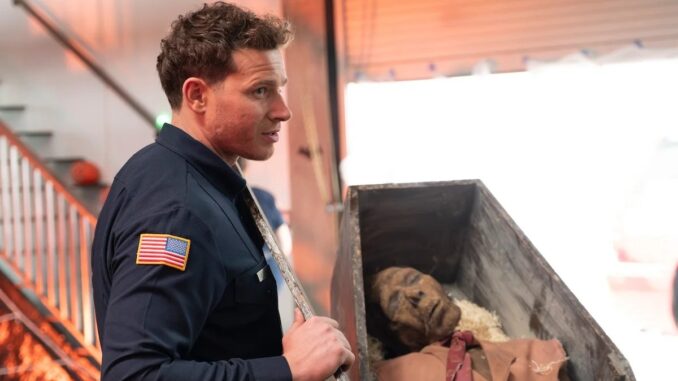
‘9-1-1’ Prop Master Reveals the Science Behind the Season 8 Skeleton
If you’ve been a fan of the hit series 9-1-1, you’ve probably noticed a strikingly lifelike skeleton making its way into some of the most suspenseful and jaw-dropping scenes in Season 8. But have you ever wondered what goes into creating such an eerie prop that’s as realistic as it is integral to the show’s dramatic moments?
In this article, we’re diving deep into the fascinating world of prop design and the unique science behind the creation of the 9-1-1 Season 8 skeleton. From intricate design choices to the process of bringing it to life, this behind-the-scenes look will reveal how Hollywood’s prop masters turn science and creativity into an unforgettable visual experience.
The Role of Props in 9-1-1: More Than Just Decoration
Before we get into the specifics of the skeleton prop, it’s important to understand the role of props on a show like 9-1-1. Props aren’t just inanimate objects—they are vital storytelling tools. They set the scene, enhance the emotional weight of a moment, and often act as silent characters within a storyline.
For 9-1-1, a show known for its dramatic rescues, intense emergencies, and unforgettable plot twists, props are designed to be as realistic as possible. Whether it’s the tools used by first responders or a chillingly lifelike skeleton, every prop is carefully chosen to keep viewers hooked.
The Skeleton’s Critical Role in Season 8
In Season 8, one particular prop stole the show: a human skeleton. It wasn’t just a backdrop—it played a pivotal role in one of the season’s most gripping episodes. From the moment it appeared on-screen, fans were left wondering: How did they get it to look so realistic? What was the secret behind its authenticity?
Let’s break down the creation process, from concept to final execution.

How a Prop Master Designs a Skeleton: The Science Behind the Creation
Creating a realistic skeleton involves more than just assembling bones. It’s a delicate balance of art, science, and technology. According to the show’s prop master, the design process for the 9-1-1 Season 8 skeleton was extensive and scientifically informed.
First, the skeleton had to be anatomically correct. That meant using references from medical professionals and real human skeletons to ensure accuracy in bone structure. Every rib, vertebra, and joint had to be positioned in the most realistic way possible to convey lifelike authenticity on screen.
Materials Matter: What Goes Into Crafting a Lifelong Skeleton
You might think a skeleton is just a bunch of plastic, but there’s a lot more science involved in the materials selection. To create a prop that looks like it could have belonged to an actual human, the team used a combination of lightweight resin and durable rubber compounds. These materials were chosen for their ability to replicate the weight and texture of bones while also ensuring that the prop could endure the demands of filming.
Interestingly, the team also incorporated several types of paint to achieve the perfect bone color. It wasn’t just about making the skeleton appear white—it was about adding subtle hues to replicate real bone, which can have shades of yellow, brown, and pink depending on its age and condition.
The Technical Aspects: Why It’s Not Just About the Skeleton
When you think of a skeleton, it’s easy to imagine a simple static prop, but creating the 9-1-1 Season 8 skeleton required a level of technical wizardry. To make the skeleton feel alive, the prop team incorporated several clever mechanisms.
One of the most impressive innovations was the inclusion of movable joints. Thanks to a combination of mechanical design and 3D printing, the skeleton’s bones could bend and twist, making it easier to position it in ways that mimicked real human movement. Whether the skeleton was posed in a dramatic rescue or during a tense crime scene investigation, this feature gave the prop an almost eerie sense of life.
Challenges in the Skeleton’s Creation: Realism vs. Filming Constraints
Creating a realistic skeleton is no easy task, and the prop master faced a number of challenges along the way. One of the biggest obstacles was balancing realism with the constraints of filming. The skeleton had to be sturdy enough to withstand multiple takes and rough handling but still look believable from every angle.
Additionally, the team had to ensure that the skeleton would fit perfectly into the action-packed world of 9-1-1. With fire trucks, ambulances, and even explosions regularly appearing in the scenes, the skeleton had to endure quite a bit of action without breaking down.
Creating the Right Atmosphere: How the Skeleton Interacts with the Scene
Props are not isolated objects—they interact with the environment and the actors around them. The team worked closely with the set designers and lighting team to ensure that the skeleton would fit seamlessly into its surroundings.
The skeleton often found itself in dimly lit scenes, such as medical emergency rooms or darkened homes, and the lighting had to be perfect to highlight its eerie qualities without making it look like a cheap prop. Shadows and strategic light placement were key to making the skeleton feel like a genuine part of the 9-1-1 universe.
The Impact on Viewers: Why It’s More Than Just a Prop
From a viewer’s perspective, the 9-1-1 skeleton is more than just an object on screen. It symbolizes the life-or-death situations that the show’s characters face every day. It reminds the audience of the high stakes involved in emergency services work, where a single mistake can mean the difference between life and death.
The realism of the skeleton allows it to evoke a stronger emotional reaction, pulling viewers deeper into the heart-pounding drama of 9-1-1.
3D Printing’s Role in Prop Creation
One of the most modern techniques used in creating the 9-1-1 skeleton was 3D printing. This cutting-edge technology allowed the prop master to design and test parts of the skeleton digitally before constructing them. This ensured every bone was accurate, and any modifications could be quickly implemented.
3D printing also helped streamline the process of making custom parts, such as the skull, which required intricate detail. Thanks to this technology, the skeleton could be built faster and with higher precision than traditional sculpting methods.
How Prop Masters Collaborate with the Cast and Crew
The creation of a prop like the 9-1-1 skeleton is not done in isolation. The prop master has to work closely with the cast, director, and crew to ensure that the skeleton functions within the story’s context. They discuss how the skeleton will be used in specific scenes and what emotional effect it’s meant to have on the audience.
For instance, in scenes where the skeleton is placed in a tense, life-threatening situation, the prop master works with the actors to ensure they interact with it in a natural, believable way. Whether they’re moving it into place or reacting to it in the midst of chaos, every detail is carefully coordinated to heighten the drama.
The Skeleton as a Symbol of Life and Death
In the context of 9-1-1, the skeleton represents much more than a physical prop. It serves as a stark reminder of the fragile line between life and death that first responders constantly walk. It embodies the show’s exploration of mortality, urgency, and the reality that life can change in an instant.
The Fans’ Reaction: How the Skeleton Became a Star
Viewers couldn’t help but talk about the 9-1-1 skeleton. Its chilling realism and pivotal role in some of the season’s most intense episodes made it a memorable part of the show. Fans began sharing images and discussions on social media, praising the detail and thought that went into creating such a powerful prop.
Conclusion: The Art and Science Behind the 9-1-1 Skeleton
The creation of the 9-1-1 Season 8 skeleton was a meticulous process that combined art, science, and technology. From its anatomical accuracy to its practical applications on set, this prop exemplifies the level of detail and care that goes into every element of the show. Thanks to the prop master and their team’s dedication, the skeleton wasn’t just a background object—it became a memorable character in its own right, symbolizing the high stakes of emergency services and the delicate balance between life and death.
FAQs
- How long did it take to create the 9-1-1 Season 8 skeleton? The skeleton took several weeks to create, including design, material selection, and 3D printing for the intricate details.
- What materials were used to create the skeleton? The skeleton was made from a combination of lightweight resin, rubber compounds, and specially designed paints to replicate real bone textures.
- How does 3D printing play a role in creating props like the skeleton? 3D printing allows for precise, quick prototyping and modification of parts, ensuring that the skeleton is anatomically correct and fits perfectly in its scenes.
- Was the skeleton used in multiple episodes of 9-1-1? Yes, the skeleton made multiple appearances throughout the season, often in pivotal moments tied to life-or-death situations.
-
How did the prop master ensure the skeleton’s realism on screen? The prop master worked closely with the lighting and set design teams to make sure the skeleton blended seamlessly into the scene, highlighting its eerie realism.
